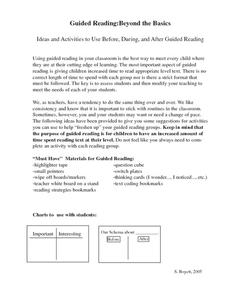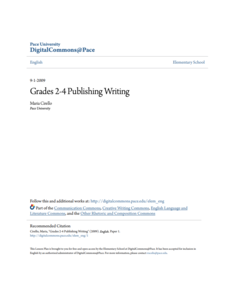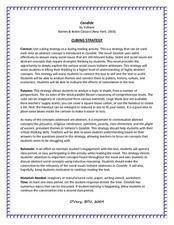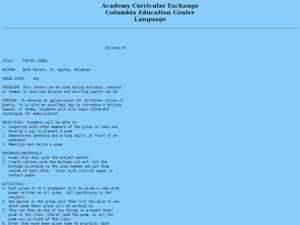Florida Center for Reading Research
Phonics: Encoding and Decoding, Letter Cube Blending
Emergent readers use a letter cube to identify, blend, and make words. They roll each of the three-letter cubes, mark down the letters they rolled, then blend the letter sounds together to make a word. They record each word on a...
Curated OER
Ordinary People: Cubing Strategy
Readers of Ordinary People employ a cubing strategy based on Bloom’s Taxonomy to analyze, from multiple perspectives, an excerpt from Chapter 10 of Judith Guest’s novel. The excerpt, a rationale and complete directions for the...
Novelinks
Zach’s Lie: Questioning Strategy – Cubing
Your class won't be a bunch of squares from using this well-rounded activity! Instead, they'll be expressing thoughtful questions using the cubing strategy. The class brainstorms questions of increasing rigor about Zach's Lie in the...
Curated OER
Tangerine: Cubing Strategy
Here's an activity that uses a reading comprehension strategy based on Bloom's taxonomy to focus readers' attention on key passages from Edward Bloor's Tangerine. Worthy of a place in your curriculum library.
Curated OER
Regarding the Fountain: Questioning Strategy—Cubing
Look deeper into the text with a reading strategy based on asking critical thinking questions. While reading Reading the Fountain by Kate Klise, learners think of questions that help them describe, compare, associate, analyze,...
Ideas From Suzi
Guided Reading: Beyond the Basics
Elevate children's reading comprehension skills with this collection of guided reading resources. From paper dice with basic comprehension questions printed on them to a system for using sticky notes to identify key...
Florida Center for Reading Research
Dictionary Cube
Young scholars investigate new vocabulary words with a fun, collaborative activity. Given a deck of word cards, pairs of students flip over one at a time and independently look up the term in a dictionary. They then take turns rolling a...
Curated OER
Maus: Cubing Questioning Strategy
Maus is the text for a postreading activity that has class members using a cubing strategy to analyze, in depth, topics (racism, past and present, forgetting/remembering the Holocaust, representing the Holocaust) associated with Art...
Pace University
Publishing Writing
Scholars become familiar with tagline literature with the help of the story, Alexander and the Horrible, No Good, Very Bad, Terrible Day by Judith Viort. After a read-aloud and whole-class discussion, leveled groups complete...
Novelinks
The Book Thief: Cubing Strategy
Whether used to review prior to a reading assessment or as a way to generate ideas for an essay, this activity is sure to encourage critical thinking about Markus Zusak's The Book Thief. Kids create a six-sided question cube with each...
Curated OER
Reading Comprehension: Fiction and Nonfiction
This resource is made up of a series of reading passages with accompanying questions. On the first page, learners read the definitions of both fiction and non-fiction. They examine four short selections before writing either fiction or...
Florida Center for Reading Research
Vocabulary: Word Meaning, Dictionary Cube
Scholars work together to define words and answer questions using a dictionary cube.
Florida Center for Reading Research
Phonics: Onset and Rime, Word-Roll-A-Rama
Learners roll two die; die one contains various onsets, and die two contains different rimes. They write down the onset and rime pair they get, then blend and read their word.
K12 Reader
Identifying Geometric Solids
After reading a short passage that identifies different types of geometric solids, kids answer a series of questions using information found in the article.
K12 Reader
3-D: It’s Not Just for Movies
This two-part reading comprehension exercise asks kids to read a short passage about cubes, rectangular prisms, spheres and pyramids, and then to respond to a series of questions about the article.
K5 Learning
Changes
You can't unring a bell, but can you unmelt an ice cube? Readers consider reversible and irreversible changes with a short informational reading passage and accompanying comprehension questions.
K12 Reader
Using Arrays for Multiplication
Using arrays for multiplication is the subject of a two-part reading comprehension worksheet that asks kids to first read a short passage about arrays and then to respond to a series of questions based on the text.
Curated OER
Brog-Cube-the Spam
A Middle school special ed class uses the acronym SPAM to learn the 4 parts of writing. They employ 4 different colors to help them visually distinguish each part of writing in a given prompt. This lesson is vague and uses a strong...
Curated OER
Candide Cubing Strategy
Candide is a dense text. To assist in analyzing Voltaire's satire, groups employ a cubing strategy based on Bloom's taxonomy. Complete directions for the strategy, a template for the cube, a worksheet, and a topic list are included.
Curated OER
Cloze Activity: Cats and Dogs
In this cats and dogs cloze procedure worksheet, learners review 2 short paragraphs that are missing 12 words and then attempt to fill in each blank with a word they think the author might have used. A word bank is provided.
Curated OER
Papaya Reading Comprehension Activity
In this papaya reading comprehension worksheet, students read a 1 paragraph selection pertaining to papaya and then answer 3 multiple choice questions regarding the information.
Curated OER
The Lightning Thief: Questioning Strategy
Step into the shoes of the Oracle from the novel, Percy Jackson and the Olympians: The Lightning Thief by Rick Riordan, with this response to reading activity. After reading chapter nine, scholars answer questions from the Oracle's point...
Reading Resource
/ue/ Word List
The final resource in a series of 16 phonemic awareness activities, designed to develop the awareness skills needed to detect the vowel sounds in words, features the /ue/ sound. Kids identify and highlight the /ue/ sound in a list of 13...
Curated OER
Poetry Cubes
Reading aloud can be scary, but it's an important way to build oral fluency. Break the class into groups of four or five learners. Each learner will roll a cube to determine which poem they read aloud to their small group. Feel free to...























